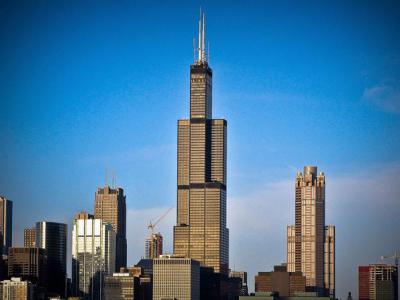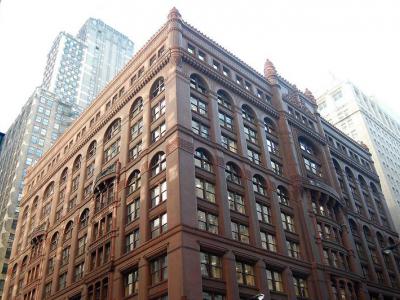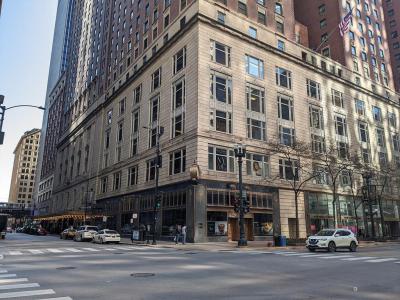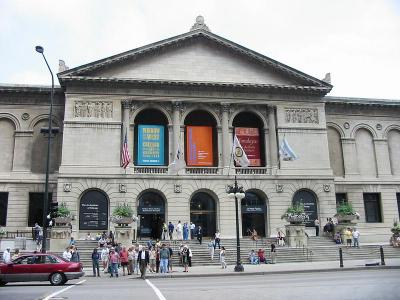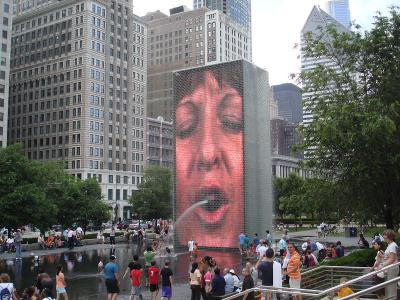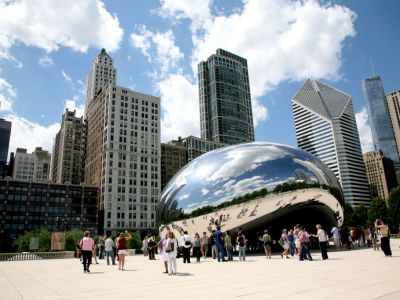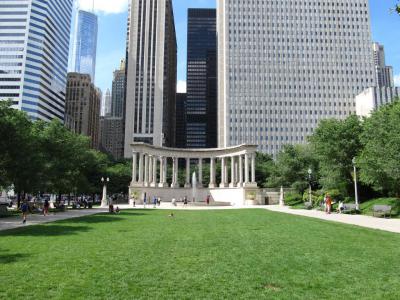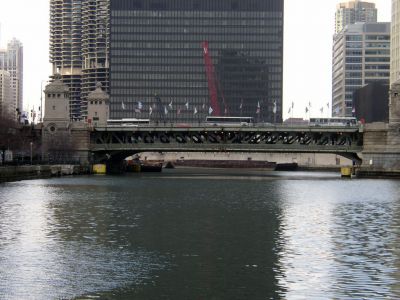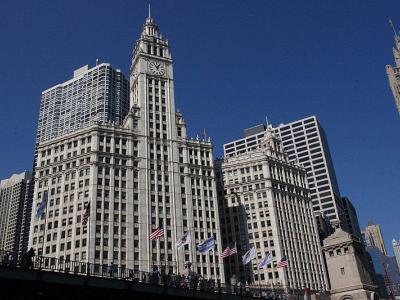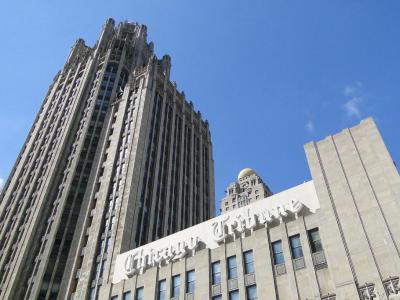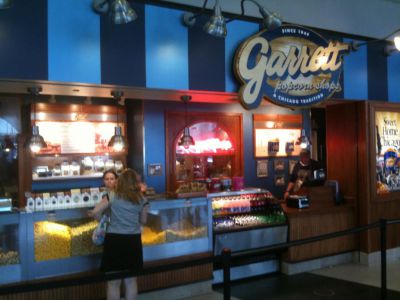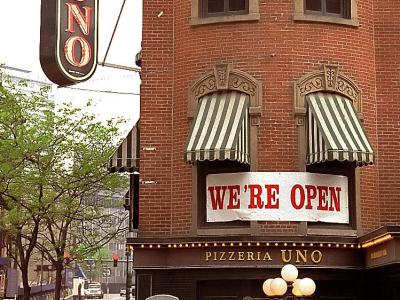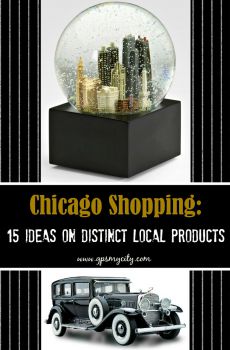Audio Guide: Chicago Introduction Walking Tour (Self Guided), Chicago
Chicago, perched on the shores of Lake Michigan in Illinois, is a city steeped in history and urban vibrancy. Known by numerous nicknames such as the Windy City and the City of Big Shoulders, it boasts a skyline marked by towering structures. The area of today's Chicago, initially inhabited by Native American tribes, saw its first European-settled reference as "Chicagou" in 1679, a name derived from the indigenous Algonquian word for wild garlic, "shikaakwa," that once grew here in large quantities. Jean Baptiste Point du Sable, regarded as Chicago’s founder, was the first non-indigenous settler in the late 18th century.
Chicago’s incorporation in 1837 marked the beginning of rapid growth, establishing itself as a crucial transportation hub in the US. The city’s expansion continued through the 1920s, drawing migrants for industrial jobs and gaining notoriety during Prohibition with figures like Al Capone. Post-Great Depression, World War II fueled a resurgence in industries, drawing a significant influx of African Americans from the South for manufacturing jobs.
The city is a pioneer in urban planning and architecture, contributing styles such as the Chicago School and steel-framed skyscrapers. It remains a bustling hub for international trade and commerce, with its tourist attractions earning it a spot among the top US cities to visit. Noteworthy landmarks include Millennium Park, known for its Cloud Gate sculpture and Crown Fountain, and the Willis Tower, one of the tallest buildings in the world.
Architectural exploration begins at the Palmer House, a historic hotel from the 19th century, perfectly located to explore the city’s core. Nearby, Wrigley Square’s Millennium Monument, a tribute to the original peristyle of 1917, offers a tranquil escape. Further exploration leads to the Wrigley Building, a beacon of Chicago’s innovative spirit, and the Tribune Tower, which incorporates stones from global landmarks into its Neo-Gothic design.
Culinary adventures are a must in Chicago. Starting at Palmer House, the birthplace of Brownie – one of America's most-loved desserts, proceed to Garrett Popcorn Shops, where the scent of their famed Chicago Mix popcorn is irresistible. Another culinary highlight is Pizzeria Uno, the cradle of Chicago-style deep-dish pizza, offering a taste of local tradition through its indulgent "pies".
Chicago’s essence is a blend of monumental architecture and Midwestern charm, inviting visitors to delve into its history, architecture, and gastronomy. Each site and flavor tells part of the grand story of this dynamic American city, making it an essential experience for travelers. For those eager to immerse themselves fully, this self-guided walk through the city’s prominent attractions is highly recommended.
Chicago’s incorporation in 1837 marked the beginning of rapid growth, establishing itself as a crucial transportation hub in the US. The city’s expansion continued through the 1920s, drawing migrants for industrial jobs and gaining notoriety during Prohibition with figures like Al Capone. Post-Great Depression, World War II fueled a resurgence in industries, drawing a significant influx of African Americans from the South for manufacturing jobs.
The city is a pioneer in urban planning and architecture, contributing styles such as the Chicago School and steel-framed skyscrapers. It remains a bustling hub for international trade and commerce, with its tourist attractions earning it a spot among the top US cities to visit. Noteworthy landmarks include Millennium Park, known for its Cloud Gate sculpture and Crown Fountain, and the Willis Tower, one of the tallest buildings in the world.
Architectural exploration begins at the Palmer House, a historic hotel from the 19th century, perfectly located to explore the city’s core. Nearby, Wrigley Square’s Millennium Monument, a tribute to the original peristyle of 1917, offers a tranquil escape. Further exploration leads to the Wrigley Building, a beacon of Chicago’s innovative spirit, and the Tribune Tower, which incorporates stones from global landmarks into its Neo-Gothic design.
Culinary adventures are a must in Chicago. Starting at Palmer House, the birthplace of Brownie – one of America's most-loved desserts, proceed to Garrett Popcorn Shops, where the scent of their famed Chicago Mix popcorn is irresistible. Another culinary highlight is Pizzeria Uno, the cradle of Chicago-style deep-dish pizza, offering a taste of local tradition through its indulgent "pies".
Chicago’s essence is a blend of monumental architecture and Midwestern charm, inviting visitors to delve into its history, architecture, and gastronomy. Each site and flavor tells part of the grand story of this dynamic American city, making it an essential experience for travelers. For those eager to immerse themselves fully, this self-guided walk through the city’s prominent attractions is highly recommended.
How it works: Download the app "GPSmyCity: Walks in 1K+ Cities" from Apple App Store or Google Play Store to your mobile phone or tablet. The app turns your mobile device into a personal tour guide and its built-in GPS navigation functions guide you from one tour stop to next. The app works offline, so no data plan is needed when traveling abroad.
Chicago Introduction Walking Tour Map
Guide Name: Chicago Introduction Walking Tour
Guide Location: USA » Chicago (See other walking tours in Chicago)
Guide Type: Self-guided Walking Tour (Sightseeing)
# of Attractions: 12
Tour Duration: 2 Hour(s)
Travel Distance: 3.9 Km or 2.4 Miles
Author: doris
Sight(s) Featured in This Guide:
Guide Location: USA » Chicago (See other walking tours in Chicago)
Guide Type: Self-guided Walking Tour (Sightseeing)
# of Attractions: 12
Tour Duration: 2 Hour(s)
Travel Distance: 3.9 Km or 2.4 Miles
Author: doris
Sight(s) Featured in This Guide:
- Willis Tower - Skydeck Chicago
- Rookery Building
- Palmer House
- Art Institute of Chicago
- Crown Fountain
- Cloud Gate
- Wrigley Square and Millennium Monument
- DuSable Bridge
- Wrigley Building
- Tribune Tower
- Garrett Popcorn
- Pizzeria Uno
1) Willis Tower - Skydeck Chicago (must see)
While London and Paris are recognized respectively for their Big Ben and Eiffel Tower, Chicago has its own architectural landmark that makes its skyline unmistakable for any other place – the Willis Tower. Designed by Skidmore, Owings & Merrill in 1974 and formerly known as the Sears Tower, the building once stood as the tallest skyscraper in the world, until 1996. Recommended by the readers of the Chicago Tribune as one of the "7 wonders of Chicago", this impressive structure rises 1,730 feet tall, spanning 110 stories. While it may have yielded its title and embraced a new name, the fascination of the Skydeck on the 103rd floor remains unmatched. On clear days, it provides breathtaking vistas encompassing the states of Illinois, Michigan, Wisconsin, and Indiana.
The journey in the elevator, lasting a mere 70 seconds, is transformed into an exhilarating experience through video monitors. Within the observatory, interactive exhibits breathe life into Chicago's visionaries, entrepreneurs, architects, musicians, and sports icons. Additionally, computer kiosks, available in six languages, aid international travelers in discovering Chicago's most sought-after destinations. Yet, for many visitors, the ultimate highlight is stepping onto the Ledge, a glass enclosure protruding 4.3 feet from the building, creating the illusion of being suspended 1,353 feet above the ground.
Despite occupying an entire city block and boasting over four million square feet of interior space, the tower was remarkably constructed in just three years. Its innovative design featured nine massive steel "tubes" of varying lengths, bundled together to provide both strength and flexibility. The concept for these distinct levels is said to have originated from the observation of someone shaking cigarettes out of a pack. Initially intended to accommodate up to 13,000 employees of the department store Sears Roebuck & Co., the tower changed hands in 1989 when it was sold to three property developers and is now home to a diverse range of commercial tenants. Remarkably, it houses one hundred elevators and 16,000 windows, all of which are thankfully equipped with automatic window-cleaning systems.
Tip:
Before deciding to ascend, it is advisable to check the visibility ratings, either on your phone or at the security desk. If visibility is less than five miles, it's best to plan your visit for another time.
The journey in the elevator, lasting a mere 70 seconds, is transformed into an exhilarating experience through video monitors. Within the observatory, interactive exhibits breathe life into Chicago's visionaries, entrepreneurs, architects, musicians, and sports icons. Additionally, computer kiosks, available in six languages, aid international travelers in discovering Chicago's most sought-after destinations. Yet, for many visitors, the ultimate highlight is stepping onto the Ledge, a glass enclosure protruding 4.3 feet from the building, creating the illusion of being suspended 1,353 feet above the ground.
Despite occupying an entire city block and boasting over four million square feet of interior space, the tower was remarkably constructed in just three years. Its innovative design featured nine massive steel "tubes" of varying lengths, bundled together to provide both strength and flexibility. The concept for these distinct levels is said to have originated from the observation of someone shaking cigarettes out of a pack. Initially intended to accommodate up to 13,000 employees of the department store Sears Roebuck & Co., the tower changed hands in 1989 when it was sold to three property developers and is now home to a diverse range of commercial tenants. Remarkably, it houses one hundred elevators and 16,000 windows, all of which are thankfully equipped with automatic window-cleaning systems.
Tip:
Before deciding to ascend, it is advisable to check the visibility ratings, either on your phone or at the security desk. If visibility is less than five miles, it's best to plan your visit for another time.
2) Rookery Building
Ah, the Rookery Building-Chicago’s architectural mic drop. Built in 1888 by Daniel Burnham and John Wellborn Root, it is where old-school charm meets cutting-edge-for-its-time innovation. Think of it as the stylish grandparent of modern office buildings-Romanesque bones, steel nerves, and a serious obsession with natural light.
Now, about that name. After the Great Fire of 1871, the city set up a temporary city hall on this very spot, right next to a water tank that, apparently, was the hottest hangout for local crows. People dubbed it “The Rookery,” a cheeky nod to both the birds and the shady politicians nesting inside. Classic Chicago...
When Burnham and Root came in, they kept the name and turned the site into an 11-story marvel. Root even carved a pair of rooks into the stone entrance, just in case you missed the reference. Inside is an architectural mixtape: fireproofing, elevators, electric lights, and a glass-roofed central light court that would make your inner plant absolutely thrive.
In 1905, Frank Lloyd Wright entered the chat. Hired to revamp the interior, he ditched Root’s ironwork and went full diva with white Carrara marble, gold-leafed arabesques, and a vibe that screams “gilded age glow-up.” The double staircase spirals like a mechanical dream, and the second-floor balcony feels like you’re walking through the inside of a very elegant watch.
Outside, it’s all brick, marble, and terra cotta-layered like an architectural tiramisu, blending Romanesque, Queen Anne, Roman Revival, and even some Art Deco from a 1931 facelift.
Want in? The Frank Lloyd Wright Trust offers tours Monday through Friday, and Inside Chicago keeps the doors open daily for curious walkers and film buffs-yes, The Untouchables and Home Alone 2 were all filmed here.
So, feel free to look up, look in, and maybe bring a rook call-just for the old time’s sake...
Now, about that name. After the Great Fire of 1871, the city set up a temporary city hall on this very spot, right next to a water tank that, apparently, was the hottest hangout for local crows. People dubbed it “The Rookery,” a cheeky nod to both the birds and the shady politicians nesting inside. Classic Chicago...
When Burnham and Root came in, they kept the name and turned the site into an 11-story marvel. Root even carved a pair of rooks into the stone entrance, just in case you missed the reference. Inside is an architectural mixtape: fireproofing, elevators, electric lights, and a glass-roofed central light court that would make your inner plant absolutely thrive.
In 1905, Frank Lloyd Wright entered the chat. Hired to revamp the interior, he ditched Root’s ironwork and went full diva with white Carrara marble, gold-leafed arabesques, and a vibe that screams “gilded age glow-up.” The double staircase spirals like a mechanical dream, and the second-floor balcony feels like you’re walking through the inside of a very elegant watch.
Outside, it’s all brick, marble, and terra cotta-layered like an architectural tiramisu, blending Romanesque, Queen Anne, Roman Revival, and even some Art Deco from a 1931 facelift.
Want in? The Frank Lloyd Wright Trust offers tours Monday through Friday, and Inside Chicago keeps the doors open daily for curious walkers and film buffs-yes, The Untouchables and Home Alone 2 were all filmed here.
So, feel free to look up, look in, and maybe bring a rook call-just for the old time’s sake...
3) Palmer House
Claimed to be the longest-running hotel in Chicago, Palmer House is known for its historical innovations. It was the first hotel in the city to use the light bulb, telephone, and elevator. Over the years, Palmer House has hosted a number of prominent individuals such as US presidents and literary giants like Charles Dickens and Oscar Wilde.
Still, the hotel's most lasting contribution to the country's heritage is one of America's most-loved desserts. Brownie was invented here.
In 1893, Bertha Palmer, the hotel's owner, asked her pastry chef to prepare a dessert to be included in the boxed lunches for ladies attending the Chicago World's Columbian Exposition. Requesting a cake-like confection, she thus gave rise to the Palmer House Brownie – a dense, chocolatey treat with a walnut and apricot glaze.
This dessert gained popularity and was first referred to as "brownie" in the Sears Roebuck Catalog in 1898. Now over a century old, its original recipe is still used for the brownie served at the Palmer House. The hotel's guests and visitors can purchase the authentic Palmer House Brownie at the on-site restaurant Lockwood Express.
Still, the hotel's most lasting contribution to the country's heritage is one of America's most-loved desserts. Brownie was invented here.
In 1893, Bertha Palmer, the hotel's owner, asked her pastry chef to prepare a dessert to be included in the boxed lunches for ladies attending the Chicago World's Columbian Exposition. Requesting a cake-like confection, she thus gave rise to the Palmer House Brownie – a dense, chocolatey treat with a walnut and apricot glaze.
This dessert gained popularity and was first referred to as "brownie" in the Sears Roebuck Catalog in 1898. Now over a century old, its original recipe is still used for the brownie served at the Palmer House. The hotel's guests and visitors can purchase the authentic Palmer House Brownie at the on-site restaurant Lockwood Express.
4) Art Institute of Chicago (must see)
Climb the grand staircase, stride past the stone-faced lions who’ve seen it all, and step into the Midwest’s reigning heavyweight of art-The Art Institute of Chicago! Housed in a sprawling Beaux-Arts palace, this museum is practically an all-you-can-absorb buffet of global creativity. And just when you think you’ve got your bearings, bam-there’s the Modern Wing, sleek and gleaming like a spaceship, courtesy of the very same Renzo Piano.
Inside, the European Collection marches through history like a very well-dressed parade-from medieval saints to moody 1950s portraits, with Renaissance drama and Baroque flair in between. But the real crowd magnet is nearly 400 Impressionist and Post-Impressionist masterpieces. Monet, Van Gogh, Cézanne-they’re all here, casually hanging out like it’s no big deal. Over in the American wing, about 5,500 works stretch across centuries, from colonial portraits to early 20th-century boldness. And if you’re into decor with a past, the Terra Foundation’s loans serve up silver, ceramics, and furniture that could easily outclass anybody's grandma’s best set.
Also, don’t skip the local favorites: the pint-sized perfection of the Thorne Miniature Rooms (imagine dollhouses with Ivy League degrees), or Chagall’s “American Windows,” where stained glass sings in color.
Coming here, you're in for more than just a gallery stroll but a full-on, globe-spanning, time-traveling art adventure. From Greek gods to Japanese screens, African masks to Warhol prints, there’s something for every curious eye. And yes, the photography collection alone could fill a day. So, do come in, wander wide, and let the lions keep watch while you get your culture fix.
Inside, the European Collection marches through history like a very well-dressed parade-from medieval saints to moody 1950s portraits, with Renaissance drama and Baroque flair in between. But the real crowd magnet is nearly 400 Impressionist and Post-Impressionist masterpieces. Monet, Van Gogh, Cézanne-they’re all here, casually hanging out like it’s no big deal. Over in the American wing, about 5,500 works stretch across centuries, from colonial portraits to early 20th-century boldness. And if you’re into decor with a past, the Terra Foundation’s loans serve up silver, ceramics, and furniture that could easily outclass anybody's grandma’s best set.
Also, don’t skip the local favorites: the pint-sized perfection of the Thorne Miniature Rooms (imagine dollhouses with Ivy League degrees), or Chagall’s “American Windows,” where stained glass sings in color.
Coming here, you're in for more than just a gallery stroll but a full-on, globe-spanning, time-traveling art adventure. From Greek gods to Japanese screens, African masks to Warhol prints, there’s something for every curious eye. And yes, the photography collection alone could fill a day. So, do come in, wander wide, and let the lions keep watch while you get your culture fix.
5) Crown Fountain
Heading south of Tribune Plaza, brace yourself for one of Chicago’s quirkiest icons-Crown Fountain, the brainchild of Spanish artist Jaume Plensa. Picture this: two towering glass monoliths, each 50 feet tall, silently facing off across a slick granite plaza. What's more-they’ve got faces. Lots of them. Hidden LED screens light up with close-ups of 1,000 real Chicagoans, captured mid-expression as they pretend to blow on a feather. The result is giant digital heads pursing their lips until-surprise!-a stream of water shoots from their mouths, giving the illusion that the city itself is spitting with playful charm. It’s weird, it’s wonderful, and yes, kids love it.
In summer, the space turns into an urban splash zone where businesspeople, toddlers, and tourists alike lose all dignity and just run through it. During the colder months, it becomes more of a sculpture garden with a twist-silent faces glowing in the frosty air like the city’s own Greek chorus.
But the magic of Crown Fountain isn’t just in the waterworks. It’s in the momentary community it creates. Strangers grin at each other as they get soaked, couples sneak kisses under the spray, and parents take far too many blurry photos. For a few minutes, nobody cares where you're from-they’re just dodging a digital spit-take together.
Swinging by, there's a good chance you'll get all in one: sunshine, shade, splashing, sitting, and sipping coffee while watching humanity be its messy, joyful self. The water’s clean, the vibe’s warm, and the maintenance crew deserves a medal. This is public art at its most entertaining-and it’s free. So, go on, get misted...
In summer, the space turns into an urban splash zone where businesspeople, toddlers, and tourists alike lose all dignity and just run through it. During the colder months, it becomes more of a sculpture garden with a twist-silent faces glowing in the frosty air like the city’s own Greek chorus.
But the magic of Crown Fountain isn’t just in the waterworks. It’s in the momentary community it creates. Strangers grin at each other as they get soaked, couples sneak kisses under the spray, and parents take far too many blurry photos. For a few minutes, nobody cares where you're from-they’re just dodging a digital spit-take together.
Swinging by, there's a good chance you'll get all in one: sunshine, shade, splashing, sitting, and sipping coffee while watching humanity be its messy, joyful self. The water’s clean, the vibe’s warm, and the maintenance crew deserves a medal. This is public art at its most entertaining-and it’s free. So, go on, get misted...
6) Cloud Gate (must see)
At the shiny center of AT&T Plaza in Millennium Park, stands the Cloud Gate - or as Chicagoans lovingly call it, The Bean. Sculpted between 2004 and 2006 by Anish Kapoor, an Indian-born British artist known for making giant shiny things that you can’t help staring at, this was his first outdoor public piece in the United States-which quickly became the selfie magnet of the Midwest.
Made from over 160 stainless steel plates seamlessly fused together (so well, in fact, you'd swear it was magic), this mirror-like blob stretches 66 feet long, stands 33 feet tall, and weighs in at a casual 100 tons. It's shaped like a drop of liquid mercury but looks more like an alien lentil from a sleek future where everything is polished to perfection.
Now, here’s the kicker: when Kapoor first proposed it, the art world blinked. Some said, “Gorgeous idea,” others said, “Logistically impossible.” Welding it, polishing it, cleaning it would be a nightmare! And yet - they pulled it off, nonetheless, although not without a few delays. When Millennium Park opened in 2004, The Bean wasn’t quite ready for its big debut. It took until May 15, 2006, for the formal unveiling, and since then it’s been soaking up praise, Instagram filters, and about ten million fingerprints a year.
Now, if you leave Chicago without a photo warped in The Bean’s belly, some may wonder if you've ever been to Chicago at all... Indeed, it's reflective, massive, and playful - and frankly, it’s probably already seen your face in someone else's selfie...
Made from over 160 stainless steel plates seamlessly fused together (so well, in fact, you'd swear it was magic), this mirror-like blob stretches 66 feet long, stands 33 feet tall, and weighs in at a casual 100 tons. It's shaped like a drop of liquid mercury but looks more like an alien lentil from a sleek future where everything is polished to perfection.
Now, here’s the kicker: when Kapoor first proposed it, the art world blinked. Some said, “Gorgeous idea,” others said, “Logistically impossible.” Welding it, polishing it, cleaning it would be a nightmare! And yet - they pulled it off, nonetheless, although not without a few delays. When Millennium Park opened in 2004, The Bean wasn’t quite ready for its big debut. It took until May 15, 2006, for the formal unveiling, and since then it’s been soaking up praise, Instagram filters, and about ten million fingerprints a year.
Now, if you leave Chicago without a photo warped in The Bean’s belly, some may wonder if you've ever been to Chicago at all... Indeed, it's reflective, massive, and playful - and frankly, it’s probably already seen your face in someone else's selfie...
7) Wrigley Square and Millennium Monument
Tucked into the northwest corner of Millennium Park-right where Michigan Avenue gives Randolph Street a firm handshake-you’ll find Wrigley Square: a leafy, sun-soaked pocket of Chicago where art, architecture, and the occasional jazz riff come out to play. Think of it as the city’s elegant front porch: perfect for lounging on the lawn, snapping photos by the fountain, or casually pretending you stumbled into a cultural event like an art show or open-air photo exhibit. Sometimes, there's live music too.
At the heart of the square stands the Millennium Monument, showing off like it’s been there since ancient Athens. In reality, it's a near-full-scale replica of the original peristyle that graced this spot from 1917 to 1953-before it was dismantled to make room for a parking lot. Fortunately, eventually, artistic taste prevailed, and the peristyle returned, complete with its proud arc of 40-foot Doric columns made of limestone, thus giving serious gravitas to an already photogenic corner of town.
Look down at the base and you’ll see the stone-etched names of 122 donors-both individuals and companies-who made Millennium Park happen. In other words, the folks who helped turn downtown from drab to dazzling. In 2017, this classical beauty got a glow-up: LED lights that change color, sleek new paving stones, and polished concrete accents that make the whole fountain plaza sparkle like it just got back from a spa retreat.
So, next time you’re in the Loop, swing by Wrigley Square. It’s got shade, it’s got charm, and it doesn’t charge admission-unless you count the cost of falling a little bit more in love with Chicago...
At the heart of the square stands the Millennium Monument, showing off like it’s been there since ancient Athens. In reality, it's a near-full-scale replica of the original peristyle that graced this spot from 1917 to 1953-before it was dismantled to make room for a parking lot. Fortunately, eventually, artistic taste prevailed, and the peristyle returned, complete with its proud arc of 40-foot Doric columns made of limestone, thus giving serious gravitas to an already photogenic corner of town.
Look down at the base and you’ll see the stone-etched names of 122 donors-both individuals and companies-who made Millennium Park happen. In other words, the folks who helped turn downtown from drab to dazzling. In 2017, this classical beauty got a glow-up: LED lights that change color, sleek new paving stones, and polished concrete accents that make the whole fountain plaza sparkle like it just got back from a spa retreat.
So, next time you’re in the Loop, swing by Wrigley Square. It’s got shade, it’s got charm, and it doesn’t charge admission-unless you count the cost of falling a little bit more in love with Chicago...
8) DuSable Bridge
Chicago boasts one of the largest collections of movable bridges in the world, with trunnion bascules being the predominant type. This particular bridge, well-suited for its prominent and bustling location, elegantly spans the river without any protruding superstructures, maintaining a generous, navigable channel. Its construction held paramount importance in the 1909 Plan of Chicago, serving as a catalyst for the rapid revitalization of real estate along North Michigan Avenue. Drawing inspiration from the design of Paris's Alexander III Bridge (1900), it features four corner pylons, decorative abutments, a gracefully flat arch profile, and seamlessly integrated embankments.
The forty-foot pylons, serving as functional operator houses, are adorned with sculptural reliefs narrating key events in Chicago's history. These include the explorations of Marquette and Joliet, the establishment of the city by trader Jean Baptiste Point du Sable, the Fort Dearborn Massacre of 1812, and the city's reconstruction following the devastating Great Chicago Fire of 1871. A commemorative plaque marks the site of the fort at the southern end of the bridge. Additionally, the southwest structure now houses a museum operated by the Friends of the Chicago River, open seasonally, providing visitors with the opportunity to observe the inner workings of the bridge's gears responsible for its opening and closing.
The forty-foot pylons, serving as functional operator houses, are adorned with sculptural reliefs narrating key events in Chicago's history. These include the explorations of Marquette and Joliet, the establishment of the city by trader Jean Baptiste Point du Sable, the Fort Dearborn Massacre of 1812, and the city's reconstruction following the devastating Great Chicago Fire of 1871. A commemorative plaque marks the site of the fort at the southern end of the bridge. Additionally, the southwest structure now houses a museum operated by the Friends of the Chicago River, open seasonally, providing visitors with the opportunity to observe the inner workings of the bridge's gears responsible for its opening and closing.
9) Wrigley Building
Just a hop, skip, and a coffee spill away from the Tribune Tower, you'll find the Wrigley Building-Chicago’s porcelain crown jewel, proudly gleaming like it just got polished for a big date. Locals love it, tourists photograph it endlessly, and the river? It just reflects it lovingly from both sides, east and west, like a doting parent.
But this beauty isn’t just showing off-it’s got history in its bones, encapsulating the essence of Chicago's architectural history up to the 1920s. Designed by the talented young architect Charles Gerhard Beersman, the structure's tripartite division draws inspiration from European traditions, a common practice among Chicago's commercial architects since the city's rebirth following the 1871 fire. Beersman was inspired by the dazzling effects of the 1893 White City designs in Chicago, leading him to embellish the building with sparkling terra-cotta cladding, using six shades of tile that start creamy at the base and ascend to a cool blue-white glow at the top. It’s like the building’s own version of a sunrise...
And at night, it doesn't go to bed either-getting lit up by a dramatic floodlight show, turning into a glowing lighthouse for downtown romantics and architecture nerds alike.
Just next door, at 401 North Wabash Avenue, is the younger, shinier neighbor: the mirrored oval Trump International Hotel & Tower. It shot up in 2008, soaring 92 stories high, briefly snagging the title of America’s second-tallest building. Originally, Donald Trump had ambitious plans to make it the world's tallest building, but these were scaled back in the aftermath of the September 11 attacks. But it still stands tall, sleek, and self-assured, curving to match the river and subtly bowing to the Wrigley Building’s elegance. Inside, it houses a luxurious hotel, opulent condos, and a fine dining establishment.
Pro tip:
Pop into the Wrigley lobby during business hours and feast your eyes on some seriously impressive brasswork. It’s like stepping into a jewelry box-only taller.
But this beauty isn’t just showing off-it’s got history in its bones, encapsulating the essence of Chicago's architectural history up to the 1920s. Designed by the talented young architect Charles Gerhard Beersman, the structure's tripartite division draws inspiration from European traditions, a common practice among Chicago's commercial architects since the city's rebirth following the 1871 fire. Beersman was inspired by the dazzling effects of the 1893 White City designs in Chicago, leading him to embellish the building with sparkling terra-cotta cladding, using six shades of tile that start creamy at the base and ascend to a cool blue-white glow at the top. It’s like the building’s own version of a sunrise...
And at night, it doesn't go to bed either-getting lit up by a dramatic floodlight show, turning into a glowing lighthouse for downtown romantics and architecture nerds alike.
Just next door, at 401 North Wabash Avenue, is the younger, shinier neighbor: the mirrored oval Trump International Hotel & Tower. It shot up in 2008, soaring 92 stories high, briefly snagging the title of America’s second-tallest building. Originally, Donald Trump had ambitious plans to make it the world's tallest building, but these were scaled back in the aftermath of the September 11 attacks. But it still stands tall, sleek, and self-assured, curving to match the river and subtly bowing to the Wrigley Building’s elegance. Inside, it houses a luxurious hotel, opulent condos, and a fine dining establishment.
Pro tip:
Pop into the Wrigley lobby during business hours and feast your eyes on some seriously impressive brasswork. It’s like stepping into a jewelry box-only taller.
10) Tribune Tower
Not far from where the Chicago River takes a polite little turn near Michigan Avenue, stands the Tribune Tower-looking less like an office building and more like a Gothic cathedral that decided to moonlight in journalism. Complete with its flying buttresses and intricate stone scrollwork, this towering marvel was finished in 1925 to house the Chicago Tribune newspaper, thanks to the generous-and let’s say flamboyant-backing of its editor-publisher Robert "The Colonel" McCormick. Together with his charmingly disheveled partner, Joseph Patterson, the Colonel kicked off a global design contest in 1922 to mark the paper’s 75th birthday. The challenge was to create the most beautiful office building in the world. No pressure, indeed...
The winning plan came from the American duo, John Mead Howells and Raymond Hood, who rebelled against the angular, mass-produced industrial decoration monotony by embracing Britain’s Arts and Crafts movement. The result was a façade crawling with sculpted flora, fauna, and cameos from Aesop’s fables-yes, that same ancient Greek guy with the talking animals. While here, don't miss the entryway stonework, where wise owls and mischievous foxes still whisper stories to the curious.
Step into the lobby and you’re greeted by patriotic marble poetry-quotations about the freedom of the press etched into nearly every surface. And then there’s the pièce de résistance: a massive relief map of North America made of plaster and shredded U.S. dollars. Fun fact: it used to include parts of South America too… until The Colonel decided to literally cut the competition.
Though the Tribune packed up its typewriters in 2018 and the place now hosts luxury condos, the building’s grandeur hasn’t skipped a beat. The outer walls still proudly display their global passport, featuring embedded stones from architectural icons like the Parthenon, the Taj Mahal, Westminster Abbey, and even the Great Wall of China. A newspaper’s vanity project? Maybe. A stunning piece of living history? Absolutely.
The winning plan came from the American duo, John Mead Howells and Raymond Hood, who rebelled against the angular, mass-produced industrial decoration monotony by embracing Britain’s Arts and Crafts movement. The result was a façade crawling with sculpted flora, fauna, and cameos from Aesop’s fables-yes, that same ancient Greek guy with the talking animals. While here, don't miss the entryway stonework, where wise owls and mischievous foxes still whisper stories to the curious.
Step into the lobby and you’re greeted by patriotic marble poetry-quotations about the freedom of the press etched into nearly every surface. And then there’s the pièce de résistance: a massive relief map of North America made of plaster and shredded U.S. dollars. Fun fact: it used to include parts of South America too… until The Colonel decided to literally cut the competition.
Though the Tribune packed up its typewriters in 2018 and the place now hosts luxury condos, the building’s grandeur hasn’t skipped a beat. The outer walls still proudly display their global passport, featuring embedded stones from architectural icons like the Parthenon, the Taj Mahal, Westminster Abbey, and even the Great Wall of China. A newspaper’s vanity project? Maybe. A stunning piece of living history? Absolutely.
11) Garrett Popcorn
Garrett Popcorn, the American chain of gourmet popcorn stores founded in Chicago in 1949, is rightfully considered part of classic Chicago cuisine. As of the latest tally, Garrett has an impressive array of – eleven – distinct popcorn flavors, available in both Crisp and Regular styles.
Among its nut-infused varieties, you'll find Pecan, Macadamia, Cashew, and Almond. Complementing these are a cornucopia of flavors such as Ranch, Caramel, Cheesy Corn, Buttery, and Plain. But perhaps the ultimate indulgence of them all is the irresistible Garrett Mix – a clever fusion of Caramel and Cheddar.
The tale of Garrett Popcorn Shops began in 1949 when the very first store sprang to life on Madison Street. Fast forward to today, Garrett has expanded its reach to nine countries and counting, with offices stationed in Chicago, Singapore, and Tokyo. And in case you didn't know, Garrett also holds the reins of the renowned Frango brand of chocolates, although, let's be clear, chocolate-covered popcorn hasn't quite made it into the serious consideration category.
The popcorn recipes at Garrett are the firm's TOP SECRET, guarded like precious treasures. In 2002, even Oprah (Winfrey) couldn't resist the allure, declaring a container of Garrett's Popcorn one of her "favorite things". Strolling along State Street, the tantalizing aroma of Garrett's signature blends wafts through the air, tempting you from a block away. The siren call of cheddar and caramel is enough to turn even the most cautious tourist into a gleeful snacker.
Tip:
To steer clear of the lines, you can place an advance order on their website. Then, simply waltz over to the pickup window at select Garrett's locations, including the one right on the Mag Mile.
Among its nut-infused varieties, you'll find Pecan, Macadamia, Cashew, and Almond. Complementing these are a cornucopia of flavors such as Ranch, Caramel, Cheesy Corn, Buttery, and Plain. But perhaps the ultimate indulgence of them all is the irresistible Garrett Mix – a clever fusion of Caramel and Cheddar.
The tale of Garrett Popcorn Shops began in 1949 when the very first store sprang to life on Madison Street. Fast forward to today, Garrett has expanded its reach to nine countries and counting, with offices stationed in Chicago, Singapore, and Tokyo. And in case you didn't know, Garrett also holds the reins of the renowned Frango brand of chocolates, although, let's be clear, chocolate-covered popcorn hasn't quite made it into the serious consideration category.
The popcorn recipes at Garrett are the firm's TOP SECRET, guarded like precious treasures. In 2002, even Oprah (Winfrey) couldn't resist the allure, declaring a container of Garrett's Popcorn one of her "favorite things". Strolling along State Street, the tantalizing aroma of Garrett's signature blends wafts through the air, tempting you from a block away. The siren call of cheddar and caramel is enough to turn even the most cautious tourist into a gleeful snacker.
Tip:
To steer clear of the lines, you can place an advance order on their website. Then, simply waltz over to the pickup window at select Garrett's locations, including the one right on the Mag Mile.
12) Pizzeria Uno
Pizzeria Uno is credited with the creation of the iconic Chicago-style deep-dish pizza. Its story began in 1943 when the restaurant was opened by Ike Sewell and Ric Riccardo. Sewell, a former insurance agent, and Riccardo, a former chef, wanted to create a new kind of pizza, distinct from the traditional thin-crust variety that was popular at the time.
The deep-dish pizza they introduced was a radical departure from the norm. Unlike traditional pizzas, which have a thin, crisp crust, deep-dish pizza features a thick, buttery crust that forms a deep pan. This pan is filled with layers of cheese, toppings, and a chunky tomato sauce on top. The result is a hearty, pizza pie that resembles a savory casserole more than a traditional pizza.
Pizzeria Uno's deep-dish pizza quickly gained popularity, and the restaurant became a staple in Chicago's dining scene. The distinctive style of pizza developed a loyal following, leading to the opening of Pizzeria Due by Sewell and Riccardo in 1955 to accommodate growing demand.
The deep-dish pizza from Pizzeria Uno has become a defining feature of Chicago's culinary identity. The original recipe and the unique preparation method have remained a closely guarded secret, but the concept has been replicated and adapted by many other pizzerias over the years.
The Pizzeria Uno at Ohio & Wabash is where the deep-dish pizza was born. Today, it is not only a historical landmark but also a symbol of Chicago's rich pizza heritage.
The deep-dish pizza they introduced was a radical departure from the norm. Unlike traditional pizzas, which have a thin, crisp crust, deep-dish pizza features a thick, buttery crust that forms a deep pan. This pan is filled with layers of cheese, toppings, and a chunky tomato sauce on top. The result is a hearty, pizza pie that resembles a savory casserole more than a traditional pizza.
Pizzeria Uno's deep-dish pizza quickly gained popularity, and the restaurant became a staple in Chicago's dining scene. The distinctive style of pizza developed a loyal following, leading to the opening of Pizzeria Due by Sewell and Riccardo in 1955 to accommodate growing demand.
The deep-dish pizza from Pizzeria Uno has become a defining feature of Chicago's culinary identity. The original recipe and the unique preparation method have remained a closely guarded secret, but the concept has been replicated and adapted by many other pizzerias over the years.
The Pizzeria Uno at Ohio & Wabash is where the deep-dish pizza was born. Today, it is not only a historical landmark but also a symbol of Chicago's rich pizza heritage.
Walking Tours in Chicago, Illinois
Create Your Own Walk in Chicago
Creating your own self-guided walk in Chicago is easy and fun. Choose the city attractions that you want to see and a walk route map will be created just for you. You can even set your hotel as the start point of the walk.
Chicago Old Town Walking Tour
Settled in 1850 by German immigrants, Chicago’s Old Town neighborhood is a popular destination for locals and visitors who cater to the entertainment venues, restaurants, pubs, coffee shops and boutiques – all of which have turned an area once referred to as the “Cabbage Patch” into an attraction that rivals Navy Pier, Wrigley Field and the Magnificent Mile.
Start your Old Town walking... view more
Tour Duration: 2 Hour(s)
Travel Distance: 2.6 Km or 1.6 Miles
Start your Old Town walking... view more
Tour Duration: 2 Hour(s)
Travel Distance: 2.6 Km or 1.6 Miles
Chicago Navy Pier Walking Tour
Additional to scenic views of the lake, the boats, and the city skyline, the Navy Pier offers a variety of attractions on the waterfront – for kids as well as adults – that draw nearly ten million people annually, making this Chicago's most visited spot. Yes, some may see it as a “tourist trap”, but it is worth the time and money to spend some time here, so take this self-guided walk... view more
Tour Duration: 1 Hour(s)
Travel Distance: 1.0 Km or 0.6 Miles
Tour Duration: 1 Hour(s)
Travel Distance: 1.0 Km or 0.6 Miles
University of Chicago Walking Tour
Founded in 1890, the University of Chicago is among the world’s most prestigious educational institutions. As of 2020, the University’s students, faculty and staff have included 100 Nobel laureates, giving it the fourth-most affiliated Nobel laureates of any university.
Set in the heart of Chicago’s famous eclectic neighborhood, Hyde Park, the campus is worth a visit as it offers a... view more
Tour Duration: 2 Hour(s)
Travel Distance: 2.5 Km or 1.6 Miles
Set in the heart of Chicago’s famous eclectic neighborhood, Hyde Park, the campus is worth a visit as it offers a... view more
Tour Duration: 2 Hour(s)
Travel Distance: 2.5 Km or 1.6 Miles
Chicago Chinatown Walking Tour
Tucked away just south of the Loop, the Chinatown of Chicago was established in 1912 and is considered one of the best examples of American Chinatown. While it may be one of Chicago’s smallest neighborhoods geographically, it is big on character, colors, sights, sounds, and flavors. Here, you’ll find a wide range of unique boutiques, specialty shops, religious sights, authentic Chinese... view more
Tour Duration: 1 Hour(s)
Travel Distance: 1.7 Km or 1.1 Miles
Tour Duration: 1 Hour(s)
Travel Distance: 1.7 Km or 1.1 Miles
Loop District Architecture Walking Tour
The Chicago Loop District-essentially the city’s historic downtown-has long been a stage for architectural innovation and an open-air museum of American architecture.
The construction boom started after the Great Chicago Fire of 1871, which destroyed much of the central business district, gave architects a blank canvas to rebuild the city from the ground up. What followed was a surge of... view more
Tour Duration: 3 Hour(s)
Travel Distance: 4.7 Km or 2.9 Miles
The construction boom started after the Great Chicago Fire of 1871, which destroyed much of the central business district, gave architects a blank canvas to rebuild the city from the ground up. What followed was a surge of... view more
Tour Duration: 3 Hour(s)
Travel Distance: 4.7 Km or 2.9 Miles
Millennium and Grant Parks Walking Tour
If Chicago had a living room, it would be Grant Park - and if it had a shiny new media room, that would definitely be Millennium Park. These two sprawling green spaces hug the lakeshore like the city’s favorite blanket, offering locals and tourists alike a perfect blend of nature, art, and architecture with a side of skyline.
Let’s start with the elder of the two - Grant Park, established... view more
Tour Duration: 2 Hour(s)
Travel Distance: 2.7 Km or 1.7 Miles
Let’s start with the elder of the two - Grant Park, established... view more
Tour Duration: 2 Hour(s)
Travel Distance: 2.7 Km or 1.7 Miles
Useful Travel Guides for Planning Your Trip
Chicago Souvenirs: 15 Distinct Local Products to Bring Home
One of the most fascinating cities in the U.S., if not the whole world, Chicago has no shortage of things closely associated with it, often due to their direct origin (blues, gangstership, etc.), so one might literally be spoiled for choice as to what to choose as a "piece" of Chicago to...
The Most Popular Cities
/ view all



